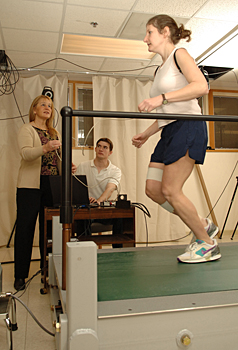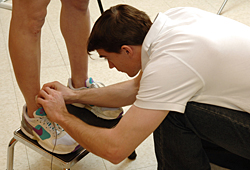
Yet, in keeping with conventional wisdom, prevention is worth more than treatment, and based on preliminary research, UD's Running Injury Laboratory is on the forefront of this wisdom.
To this end, Irene Davis, UD professor of physical therapy, director of the University's Running Injury Laboratory and director of research for Drayer Physical Therapy Institute, recently was awarded $1.3 million in grants from the National Institutes of Health (NIH) and the Department of Defense (DOD) for her ongoing work on reducing the risk of stress fractures.
“Preliminary studies have yielded positive evidence,” Davis said. “Stress fractures develop when there is repeated and extreme loading on bones weakened by an imbalance between new bone formation and bone loss, and my intent has always been that, once we were able to understand the running mechanics associated with these types of fractures, we would work to find methods to alter these mechanics and, it is hoped, prevent them.”
The fractures, she added, most often occur in the tibia, the larger of the two bones in the leg below the knee, and are likely to affect runners who experience high-shock loads or land harder as they run.
“If someone happens to have a relatively high load when they run, they put themselves at greater risk for stress fractures,” Davis said. “When you hit harder, you naturally have a greater load to dissipate.” The rate of re-injury, she added, is a dismayingly high 36 percent.
“An individual can go and rest and calm the injury down,” Davis said, “but if he or she has the same mechanics going back into a routine, they are at increased risk for another fracture. Our feeling is that if the mechanics are related to the injury, then we need to alter the mechanics.”
If results from preliminary biofeedback studies conducted by Davis at UD's Running Injury Laboratory hold true, gait retraining addresses this. Results for altering mechanics for the better are so promising, in fact, that runners who participated in initial studies were able to change their faulty gaits in eight half-hour sessions, reducing their leg shock by 50 percent.
“The preliminary data we've developed show that runners, when provided with feedback on their gait, can indeed reduce their loads by about 50 percent, compared with cushioning shoes that might result in a reduction of 10 percent,” Davis, who presented her research at the Experimental Biology 2007 meeting in Washington, D.C. on Monday, April 30, said. “This leads me to believe that we have a greater ability to alter mechanics through biofeedback than through external devices such as shoes.”Davis said research funded by the grants will involve screening study participants for faulty gaits, retraining them with an accelerometer and a biofeedback monitor, and testing them at the end of the study and again in one, six and 12 months to analyze their tibial impacts.
Individuals will run on a force treadmill with an accelerometer attached to their lower legs that measures their impact and then translates that g-force--the measurable force of gravity--into a spike that's shown on a monitor in front of them. The runner must then constantly adjust the force of each foot strike to reduce high spikes--measured at around 8-10 g's--to less punishing, more low-risk shocks--measured at around 4-6 g's, Davis said.
“When runners can get information on their impact and see how to make a softer landing, preliminary evidence suggests they can reduce their load by about 50 percent,” she said.
Following a treadmill accommodation period, subjects will undergo the retraining. Run time will be gradually increased and feedback gradually decreased over eight sessions. Subjects will then have their gaits analyzed for tibial impact and ground reaction forces immediately following clinical testing and again at one, six and 12 months. As part of the DOD grant, Davis and colleagues will be investigating how running softer affects loads in the tibia itself. Mathematical modeling will be used to estimate reductions in bone strain after the subject learns to run softer.
Runners from 16-40 years of age, Davis said, are now being sought for the study. To be considered, participants must run at least 10 miles a week and demonstrate (through a treadmill test conducted at UD) high-shock impact when they run. To learn more, call Michael Pohl at (302) 831-4646.
Article by Becca Hutchinson and Barbara Garrison
Photos by Kathy Atkinson



